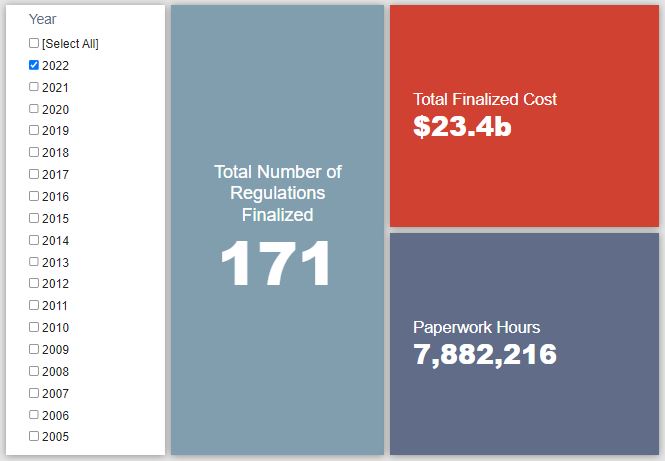Week in Regulation
September 26, 2022
Finding Cost Savings for Pilots and School Lunches
Overall, last week was a relatively muted one in the pages of the Federal Register. There were some notable actions at the margins, however. Despite modest net increases in costs and paperwork – driven primarily by a handful of routine airworthiness directive rules – the most interesting actions involved agencies finding nominally cost-saving measures for affected entities in the respective areas of airplane pilot qualifications and school lunch programs. Across all rulemakings, agencies published $119.3 million in total net costs and added 43,959 annual paperwork burden hours.
REGULATORY TOPLINES
- Proposed Rules: 36
- Final Rules: 71
- 2022 Total Pages: 58,158
- 2022 Final Rule Costs: $23.4 billion
- 2022 Proposed Rule Costs: $127.7 billion
NOTABLE REGULATORY ACTIONS
The significant rulemaking of the week (from a policy perspective, at least) was a Federal Aviation Administration (FAA) rule entitled “Recognition of Pilot in Command Experience in the Military and Air Carrier Operations.” The rule would provide savings to “pilots and air carriers by expanding opportunities for pilots that meet the amended criteria to use relevant flight experience toward the requirements for an ATP [airline transport pilot] certificate and to meet PIC [pilot in command] qualification requirements for air carrier operations.” In particular, it “allows credit for select military time in a powered-lift flown in horizontal flight towards the 250 hours of airplane time as PIC, or second in command (SIC) performing the duties of PIC, required for an airline transport pilot (ATP) certificate.” FAA estimates that this rule will yield $21.5 million in monetized savings over a 10-year period.
TRACKING THE ADMINISTRATIONS
As we have already seen from executive orders and memos, the Biden Administration will surely provide plenty of contrasts with the Trump Administration on the regulatory front. And while there is a general expectation that the current administration will seek to broadly restore Obama-esque regulatory actions, there will also be areas where it charts its own course. Since the AAF RegRodeo data extend back to 2005, it is possible to provide weekly updates on how the top-level trends of President Biden’s regulatory record track with those of his two most recent predecessors. The following table provides the cumulative totals of final rules containing some quantified economic impact from each administration through this point in their respective terms.
![]()
The pilot rule discussed above provided the bulk of the admittedly minimal shift in the Biden Administration’s final rule cost total. The Obama Administration also saw limited changes in its running tally, with costs and paperwork increasing by $42 million and nearly 11,000 hours, respectively. The most significant development across any of the administrations came from the Trump Administration’s cost total. Due primarily to a deregulatory Department of Energy rule on LED lights, the Trump-era cost total continued its dive into net-savings territory by nearly $770 million.
THIS WEEK’S REGULATORY PICTURE
This week, streamlining school lunch regulations.
On September 19, the Department of Agriculture’s Food and Nutrition Service (FNS) published a final rule in the Federal Register that makes changes to federal school lunch programs.
The crux of the rule makes permanent regulatory relief regarding four aspects of the previous regulations. The FNS had, prior to a March 2018 Office of Inspector General (OIG) report, waived certain program requirements of the Summer Food Service Program (SFSP) on a nationwide basis through policy memos. The OIG report, however, found that the FNS lacked the authority to issue such broad waivers in this manner. The agency, accordingly, proposed regulatory fixes in 2020 that it finalized in this week’s rule.
The first change amends a requirement that plan sponsors, primarily schools, visit each of their program sites within the first week of operation. A second change offers more flexibility for what times meals can be offered. A third fix pertains to “offer versus serve,” which makes permanent a previous waiver allowing sponsors to let kids refuse parts of the meal they do not intend to eat in order to reduce food waste. The fourth modification makes it easier for school facilities that are closed during the summer to prove eligibility.
The final rule also makes permanent streamlined application procedures for sponsors that are in good standing, which extends beyond the SFSP to other programs, including the National School Lunch Program.
The FNS anticipates modest economic savings of between $2.2–$4.3 million over five years from reduced reporting and recordkeeping costs. The final rule goes into effect on October 1, and the compliance date is May 1, 2023.
TOTAL BURDENS
Since January 1, the federal government has published $151.1 billion in total net costs (with $23.4 billion in new costs from finalized rules) and 81.7 million hours of net annual paperwork burden increases (with 7.9 million hours in increases from final rules).












